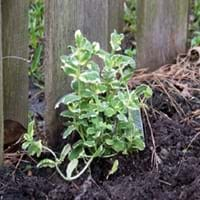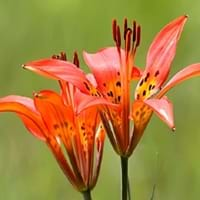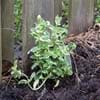Life Span
Perennial
Perennial
Type
Herbs
Bulb or Corm or Tuber
Origin
Southern Europe
Northeastern United States, Mid-Atlantic United States, Southeastern United States, North-Central United States, Central United States, South-Central United States, Western United States, Southwestern United States, Texas, Canada
Types
Not Available
western red lily
Habitat
Cultivated Beds, Dappled Shade, Shady Edge, Sunny Edge, Woodland Garden
High elevation, Hill prairies, Open grasslands
USDA Hardiness Zone
6-9
3-8
Sunset Zone
4, 5, 6, 7, 8, 9, 10, 11, 12, 13, 14, 16, 17, 18, 19, 20, 21, 22, 23, 24
21,22
Habit
Spreading
Upright/Erect
Minimum Width
Not Available
Flower Color
White, Pink
Dark Red, Orange Red
Flower Color Modifier
Bicolor
Bicolor
Fruit Color
Brown
Yellow green, Sandy Brown
Leaf Color in Spring
White, Light Green
Light Green
Leaf Color in Summer
White, Light Green
Light Green
Leaf Color in Fall
White, Light Green
Several shades of Green
Leaf Color in Winter
Light Green
Light Green
Leaf Shape
Oval
Long linear and narrow
Plant Season
Spring, Summer, Fall
Summer
Sunlight
Partial Sun, Partial shade
Full Sun, Partial Sun, Partial shade
Type of Soil
Clay, Loam, Sand
Clay, Loam, Sand
The pH of Soil
Acidic, Neutral
Neutral
Soil Drainage
Poorly Drained
Well drained
Bloom Time
Summer
Summer, Late Summer
Tolerances
Drought
Drought
Where to Plant?
Container, Ground, Pot
Ground, Pot
How to Plant?
By dividing rhizomes, tubers, Stem Cutting
Bulbs
Plant Maintenance
Medium
Medium
Watering Requirements
Average Water Needs, Do Not over Water, Requires regular watering
Keep the Soil well drained
In Summer
Lots of watering
Lots of watering
In Spring
Moderate
Moderate
In Winter
Average Water
Average Water
Soil pH
Acidic, Neutral
Neutral
Soil Type
Clay, Loam, Sand
Clay, Loam, Sand
Soil Drainage Capacity
Poorly Drained
Well drained
Sun Exposure
Partial Sun, Partial shade
Full Sun, Partial Sun, Partial shade
Pruning
Prune in the growing season, Remove damaged leaves, Remove dead branches, Remove dead leaves
Remove damaged leaves, Remove dead branches, Remove dead leaves
Fertilizers
All-Purpose Liquid Fertilizer, Fertilize in early spring
Acidic Fertilizer, All-Purpose Liquid Fertilizer
Pests and Diseases
Red blotch
Gray mold, Lily Beetle
Plant Tolerance
Drought
Drought
Flower Petal Number
Single
Single
Fragrant Bark/Stem
Yes
No
Foliage Texture
Medium
Medium
Foliage Sheen
Matte
Matte
Attracts
Bees, Butterflies, pollinators
Birds, Hummingbirds
Allergy
Itchiness, Skin rash, Stomach pain, Swelling
poisonous to cats
Aesthetic Uses
Bonsai, Showy Purposes
Borders, Cottage Garden, Ornamental use, Wild gardens
Beauty Benefits
Good for skin
Not Available
Edible Uses
Yes
Sometimes
Environmental Uses
Air purification
Air purification
Medicinal Uses
Antiseptic, Digestive disorders, Fever, Headache
Not Available
Part of Plant Used
Fruits, Leaves
Not Available
Other Uses
Added to salads, Used as essential oil, Used in making tea, Used to make herbal teas
bulb used as starch, Unknown
Used As Indoor Plant
Yes
Yes
Used As Outdoor Plant
Yes
Yes
Garden Design
Bog Garden, Edible, Groundcover, Herb / Vegetable
Feature Plant, Mixed Border, Wildflower
Botanical Name
MENTHA suaveolens 'Variegata'
LILIUM philadelphicum
Common Name
Applemint, Variegated Applemint
Philadelphia Lily, Wood Lily
In Hindi
Applemint Tree
wood lily
In German
Applemint Baum
Lilium philadelphicum
In French
Applemint Arbre
Lilium philadelphicum
In Spanish
Árbol Applemint
lirio de madera
In Greek
Applemint Δέντρο
ξύλο κρίνος
In Portuguese
Árvore applemint
wood lily
In Polish
Applemint Drzewo
lilia drewna
In Latin
Applemint ligno
wood lily
Phylum
Magnoliophyta
Magnoliophyta
Class
Magnoliopsida
Liliopsida
Family
Lamiaceae
Liliaceae
Clade
Angiosperms, Asterids, Eudicots
Angiosperms, Monocots
Tribe
Mentheae
Not Available
Subfamily
Faboideae
Lilioideae
Number of Species
Not Available
Not Available
Importance of Applemint and Wood Lily
Want to have the most appropriate plant for your garden? You might want to know the importance of Applemint and Wood Lily. Basically, these two plants vary in many aspects. Compare Applemint and Wood Lily as they differ in many characteristics such as their life, care, benefits, facts, etc. Every gardener must at least have the slightest clue about the plants he wants to plant in his garden. Compare their benefits, which differ in many ways like facts and uses. The medicinal use of Applemint is Antiseptic, Digestive disorders, Fever and Headache whereas of Wood Lily is Not Available. Applemint has beauty benefits as follows: Good for skin while Wood Lily has beauty benefits as follows: Good for skin.
Compare Facts of Applemint vs Wood Lily
How to choose the best garden plant for your garden depending upon its facts? Here garden plant comparison will help you to solve this query. Compare the facts of Applemint vs Wood Lily and know which one to choose. As garden plants have benefits and other uses, allergy is also a major drawback of plants for some people. Allergic reactions of Applemint are Itchiness, Skin rash, Stomach pain and Swelling whereas of Wood Lily have poisonous to cats respectively. Having a fruit bearing plant in your garden can be a plus point of your garden. Applemint has no showy fruits and Wood Lily has no showy fruits. Also Applemint is flowering and Wood Lily is not flowering . You can compare Applemint and Wood Lily facts and facts of other plants too.





